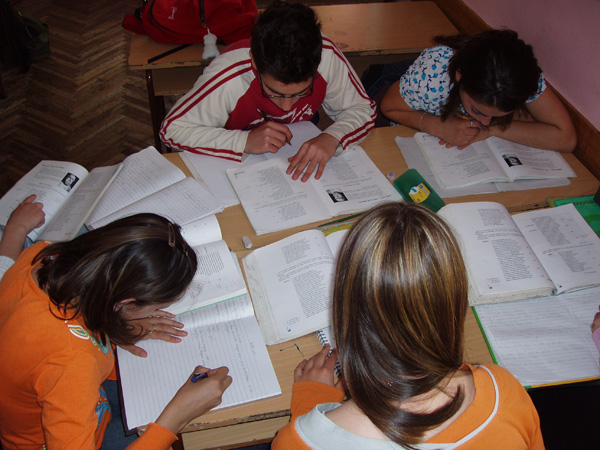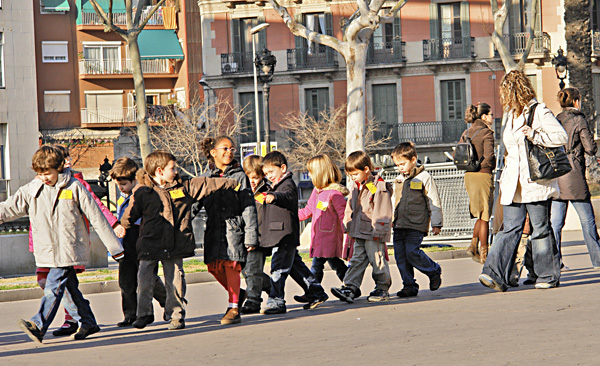Click here for the PDF version of this article
Expecting all children the same age to learn from the same materials is like expecting all children the same age to wear the same size clothing. – Madeline Hunter
While an abundance of research exists pointing to effective strategies to use with gifted and talented students, and those to use with English Language Learners (ELLs), there is a dearth of research focused on the best strategies for teachers to use in educating ELLs who are identified as gifted. According to the California Census, the percentage of the population speaking a language other than English rose from 39.5% in 2000 to 43.7% in 2014. If districts are in fact identifying more Spanish speaking students as gifted, as the latest push has called for, then educators need to know how to best meet their needs in the classroom.
The Classroom Today
 The Common Core State Standards (2010) call upon educators around the nation to provide instruction that is “aligned with college and work expectations,” “rigorous,” and “internationally benchmarked.” The CCSS also “lay out a vision of what it means to be a literate person in the twenty-first century.” The expectation is that educators will provide the means by which every student in a public school will be educated – that is, with the same level of rigor so as to meet the same expectation.
The Common Core State Standards (2010) call upon educators around the nation to provide instruction that is “aligned with college and work expectations,” “rigorous,” and “internationally benchmarked.” The CCSS also “lay out a vision of what it means to be a literate person in the twenty-first century.” The expectation is that educators will provide the means by which every student in a public school will be educated – that is, with the same level of rigor so as to meet the same expectation.
Not all students sitting in desks across California arrive with the same background knowledge, exposure to the English language, cultural practices that mirror those of the mainstream USA, or ability to interact and communicate directly with others in the school setting. They do, however, arrive with background knowledge rooted in their own culture, deep exposure to their home language (for the purposes of this article we will refer to native Spanish speakers), their own cultural practices, and the ability to interact and communicate directly with others in their own familiar settings. Educators must learn how to reach out to, differentiate, scaffold, and assist gifted ELLs in the classroom in light of the rigorous demands of CCSS instruction coupled with the challenges presented by such vast cultural and linguistic differences.
Gifted students are often born with similar characteristics and attributes (Webb, Gore, Amend, DeVries, 2007); they also tend to exhibit particular attitudes and behaviors. Collectively, these characteristics can be matched with strategies for classroom instruction that are proven effective with ELLs. The following list provides suggestions for methods and strategies that should be used when differentiating the CCSS for gifted ELLs, or native Spanish speakers.
Suggested Strategies to use with Gifted ELLs
Characteristics of Gifted Children – Suggested Strategy for the Gifted ELL
Unusual alertness, even in infancy – Teach the child in his native tongue as well as begin to develop his English as early as the preschool years.
Rapid learner; puts thoughts together quickly – Provide English language instruction at a much faster pace; provide language and content instruction simultaneously.
Excellent memory – Expose the young child to the alphabet, numbers, reading instruction, Spanish-English cognates and vocabulary as early as preschool; expose the older student to academic and domain-specific vocabulary and the conventions of grammar at a much faster pace while connecting this learning to the student’s knowledge in his primary language.
 Unusually large vocabulary and complex sentence structure for age – Do not “dumb down” the material or the pace; expose the student to mentor texts in English so he has numerous models of quality writing coupled with instruction. Students, especially ELLs, benefit greatly from exposure to models of the work educators expect to see. (Kinsella 2015)
Unusually large vocabulary and complex sentence structure for age – Do not “dumb down” the material or the pace; expose the student to mentor texts in English so he has numerous models of quality writing coupled with instruction. Students, especially ELLs, benefit greatly from exposure to models of the work educators expect to see. (Kinsella 2015)
Advanced comprehension of word nuances, metaphors, and abstract ideas – Increase the student’s exposure to nuances, metaphors, and abstract ideas of the English language, and to as many Spanish-English cognates as possible (for a comprehensive list see http://www.colorincolorado.org/pdfs/articles/cognates.pdf).
Enjoys solving problems, especially with numbers and puzzles – Provide students with non-language-based puzzles and problems to solve; ELLs will build academic confidence in math sooner than they will in English Language Arts.
Often self-taught reading and writing skills as preschooler – Assess younger preschool-aged children in their native tongue to measure early literacy skills; students will transfer these skills as they acquire new language.
Deep, intense feelings and reactions – Provide opportunities for students to speak in their native tongue about their emotions with other Spanish-speakers; increase the student’s exposure to visual and performing arts as these often serve as nonverbal avenues for emotional connections.
Highly sensitive – Be aware of the non-verbal cues that children exhibit when they are emotionally upset, angry, distraught, etc., and provide an outlet or a rest time, an opportunity to check out for a minute.
Thinking is abstract, complex, logical, and insightful – Invite students to play with ideas in their native tongue, then pair them with bilingual students to share out verbally; offer opportunities to engage in the arts and engineering-based projects which embrace this type of thinking.
Idealism and sense of justice at early age – Allow time in the classroom to work out conflicts; teach students a structure for discussing and working through and beyond conflict.
Concern with social and political issues and injustices – Expose the student to current events; encourage the student to have discussions with their parents about these current events.
Learn basic skills quickly and with little practice – Pre-assess the student when possible and use the results to inform future instruction; all students deserve to receive credit for what they already know and to move forward from that point.
Asks probing questions – Through direct teaching and utilizing the Prompts of Depth and Complexity (Kaplan), invite the student into a discussion through pictorial/nonlinguistic representations that prompt higher level thinking skills. As students acquire the English language, provide sentence frames to guide them in collaborative conversations. Older students will benefit from engaging in structured dialogue settings such as the Socratic Seminar and Philosophical Chairs.
Wide range of interests (or extreme focus in one area) – Provide the student with well-structured Independent Study opportunities; pair him with a mentor who is bilingual. Always inform students and their families about local library opportunities so students can have endless access to books on topics of interest.
Interest in experimenting and doing things differently – Invite DIFFERENCE; encourage the student to try multiple ways of solving problems.
 Puts idea or things together that are not typical – Do not criticize the student’s ideas even if the ideas seem outlandish; they may be brilliant ideas, but stifled by the challenge of not having the English language mastered.
Puts idea or things together that are not typical – Do not criticize the student’s ideas even if the ideas seem outlandish; they may be brilliant ideas, but stifled by the challenge of not having the English language mastered.
Keen and/or unusual sense of humor – Expose students to common American idiomatic expressions, figurative language, and humor so they can gain access to their meaning.
Author Sandra Cisneros has been acclaimed as the first Mexican American female to publish a book through a mainstreaming publishing company. She claims that it was one of her high school teachers who encouraged her writing; this teacher took three critical steps in Cisneros’s education:
- Identify, validate, nurture, and teach her how to apply her interests and strengths (i.e., creative writing) productively.
- Create motivation for continued academic learning.
- Provide a personal connection to school in the form of a mentor relationship. (Smutny, et. al. 2012).
No teacher can possibly know with certainty how far her students will succeed, in which careers her students will thrive, or who will be published or hold an important public office. However, every teacher should treat every student as if he or she might accomplish anything in life!
Gina Estrada Danley is a Teacher on Special Assignment in the Santa Maria-Bonita School District. She holds a Bachelor of Arts in Speech Communication and a Master of Arts in Reading and Literacy from Cal Poly, San Luis Obispo. Gina works with the Gifted and Talented Program in her district and she provides professional development in the area of ELA/ELD and Literacy of the Common Core State Standards. She is one of four authors of Discovering and Developing Talents in Spanish-Speaking Students (2012). She is the Educator Representative for the California Association for the Gifted and co-president of the Tri-County GATE Council.
Click to return to the GEC Summer 2015 Table of Contents
References
"Census.gov." 15 May. 2015 <http://www.census.gov/>
"Common Core State Standards – Resources (CA Dept of …" 2012. 15 May. 2015 <http://www.cde.ca.gov/re/cc/>
Kinsella, K. Presentation, San Luis Coastal Unified School District, San Luis Obispo, CA: May 2015.
Smutny, Joan Franklin et al. Discovering and Developing Talents in Spanish-Speaking Students. Corwin Press, 2012.. Thousand Oaks, CA: Corwin.
Webb, J., Gore, J., Amend, E., DeVries, A. (2007). A parent’s guide to gifted children. Tucson, AZ: Great Potential Press, <http://www.greatpotentialpress.com/>